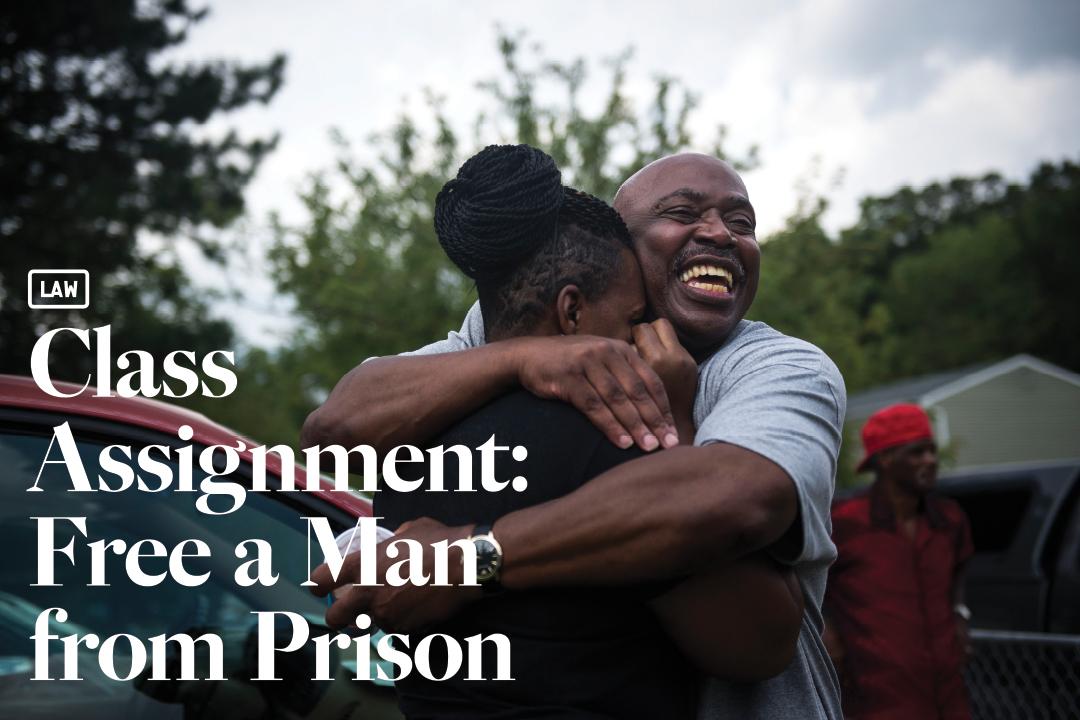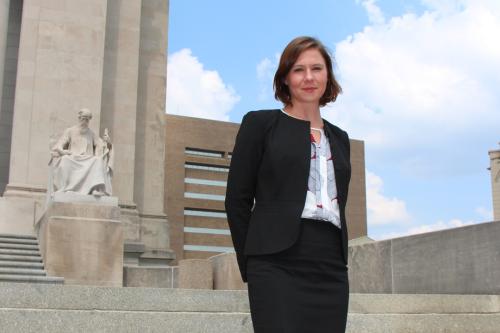Law School Assignment
Rudolph Norris hugs Janice, a niece who had not seen him since she was 7, after his release from federal prison, in Upper Marlboro, Md., July 28, 2015. (Photo: Gabriella Demczuk/The New York Times/Redux)
As law students, Courtney Francik and Bart Sheard petitioned
President Obama to commute a man's sentence—and he did.
By Ruth Steinhardt
Courtney Francik, JD ’15, was a third-year student at GW Law School when she started working to free a man who had been in prison almost as long as she had been alive.
Seeking practical clinical experience before she began a legal career, Ms. Francik had signed up for the law school’s Neighborhood Law and Policy Clinic. Under the supervision of clinic founder and Associate Professor of Clinical Law Jessica Steinberg, the program offers class credit each semester to 10 students who represent prisoners and people whose criminal records make it difficult to find jobs or housing.
When Ms. Francik enrolled in 2014, the clinic was branching out into a new arena. That April, the Department of Justice had announced a new clemency initiative for federal prisoners convicted of nonviolent, low-level offenses. Ms. Francik and her clinic partner, Bart Sheard, JD ’15, were assigned the clinic’s first clemency case: a D.C. native in his late 50s named Rudolph Norris.
In 1992, police found 29 grams of crack cocaine in Mr. Norris’ car. It was the height of the war on drugs, and repeat offenders received mandatory sentences much longer than they would have if convicted today. Mr. Norris was sentenced to 30 years in federal prison—even though, according to an article in The New York Times, a presentencing report stated unequivocally that "there was no victim in this offense.”
In prison, the Times wrote, Mr. Norris had committed to a clean record. (Phone calls to Mr. Norris seeking comment for this story were not returned by press time.)
He took a course as an electronics inspector and, in 22 years of imprisonment, had only three minor disciplinary violations. He was an almost ideal candidate for clemency.
Ms. Francik had some experience with prisoners’ rights—and with the tortuous convolutions of the federal court system. "We selected Courtney because she had interned over the summer at the federal public defender’s office, so she had some experience in a notoriously complex area of law,” says Ms. Steinberg, the clinic supervisor.
Still, Ms. Francik says, she had no real idea what to expect. Applicants for clemency had to meet a number of prerequisites, and, since the federal program was a new one, there were no precedents to study.
"I was very excited and very anxious,” she remembers. "There were a number of different factors that the pardon attorney and the president were interested in in determining to grant clemency. They ranged from pretty formulaic things—the sentencing guidelines [at the time of conviction] and how they operated—to things that had more to do with the individual person, their conduct while incarcerated.”
That being so, Ms. Francik and Mr. Sheard wanted to get to know the man for whom they would be advocating. They exchanged letters and spoke often by phone, and in November 2014 the pair traveled to the Federal Correctional Institution in Morgantown, W.Va., to meet Mr. Norris in person.
Ms. Francik was immediately charmed. "He’s such a personable guy—very friendly, loves to talk, open, honest. He’s just fun.”
The meeting reinforced the urgency of their mission. "We’d get to clinic really early and just be there all day,” she says. She and Mr. Sheard became familiar with the minutia of Mr. Norris. They pored over records and transcripts. They spoke to his family, to his former lawyers and to prison officials who had supervised him. When the semester ended, Ms. Francik chose to continue at the clinic for the spring 2015 semester in order to finish out the case—an unusual commitment, Ms. Steinberg says. Finally, in February, Rudolph Norris’ clemency petition was complete. It was 182 pages.
"The most challenging part of the whole case was turning it over when it was finished—worrying that there was a typo, or we’d made a mistake,” Ms. Francik says.
"We got to be the ones that called Mr.Norris] to tell him his petition had been granted. There were definitely some tears-happy tears-involved."
Then they waited. A month and a half later, on March 31, the clinic phone rang: It was a White House lawyer. Mr. Norris was one of 22 people selected by President Barack Obama to receive clemency.
"Bart and I met in the [clinic] office and we got to be the ones that called [Mr. Norris] to tell him his petition had been granted,” Ms. Francik recalled. "There were definitely some tears—happy tears—involved.”
In late July, Mr. Norris walked out of prison to the waiting arms of family.
Ms. Francik’s absorption in the case, and its happy ending, sealed Ms. Francik’s career path. Now she works as an attorney in the Public Defender’s Office of Shelby County, Tenn., and is a fellow of Gideon’s Promise, an organization founded by Jonathan Rapping, JD ’95, that trains public defenders to advocate for marginalized clients despite limited time and resources.
She is constantly in the courtroom, on the front lines of defense for those who, like Mr. Norris, could be disproportionately penalized by the criminal justice system. The work is "hectic,” she says, but still she tries to build in-depth relationships with the people she represents.
"I think it’s always a good thing to get to know a client personally,” she says. "You need to know what’s important to them.”
Other Spring Features
Poetry in Motion
A second-career English teacher helps kids find their voice and confidence in school through "wrestling with words."
The Ball is in his Court
Former GW tennis star David Haggerty recently took the helm of the sport's international governing body.





